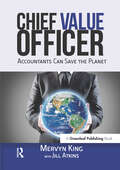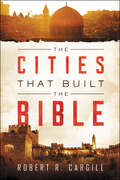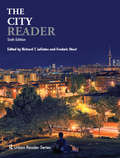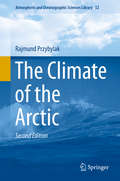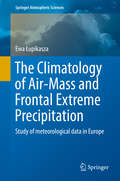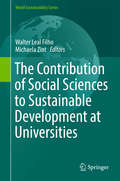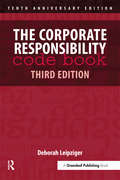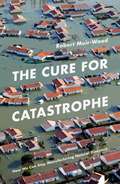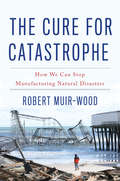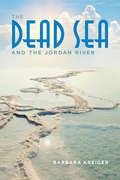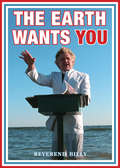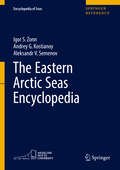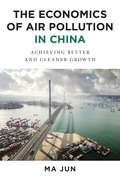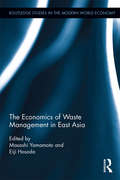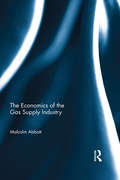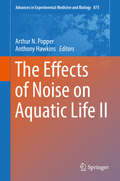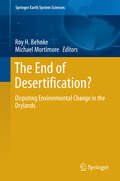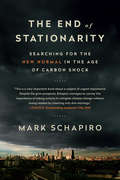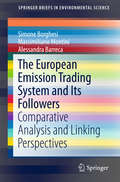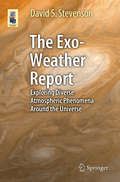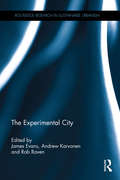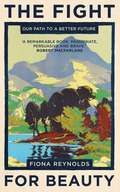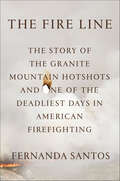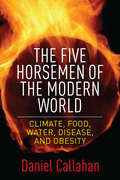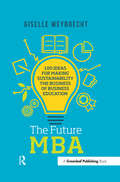- Table View
- List View
The Chief Value Officer: Accountants Can Save the Planet
by Jill Atkins Mervyn KingIntegrated Reporting is having a profound impact on corporate thinking and reporting. Value is being assessed on the basis of the sources of value creation used by an organisation and not through a financial lens alone. In Chief Value Officer: Accountants Can Save the Planet, Mervyn King, a global corporate governance and reporting leader, challenges some of the systemic issues preventing organisations from managing in an integrated value-creation way.The shareholder-centric governance model, currently favoured by most companies, will not result in changes to corporate behaviour that can create value in a sustainable manner. The book, therefore, firmly places the accountant in the position of changemaker – the finance professional today should be more of a value officer than a financial officer. Consequently, the Chief Finance Officer should be known as the Chief Value Officer.This book explains this new approach. It encapsulates the essential reasons for adopting integrated reporting, explains its application to date and proposes the next steps needed to achieve change that will improve business, social and environmental sustainability.
The Cities That Built the Bible
by Robert R. Cargill“An expert guide and teacher . . . delves into difficult topics with humor and ease. . . . Well worth reading.” —Biblical ArcheologyFor many, the names Bethlehem, Babylon, and Jerusalem are known as the setting for epic stories from the Bible. What often gets missed is that these cities are far more than just the setting for the Bible and its characters—they were instrumental to the creation of the Bible as we know it today.Robert Cargill, archeologist, Bible scholar, and host of the History Channel series Bible Secrets Revealed, blends archaeology, biblical history, and personal journey as he explores ancient cities and their role in the creation of the Bible. He reveals surprising facts such as what the Bible says about the birth of Jesus and how Mary’s Virgin Birth caused problems for the early church. We’ll also see how the God of the Old Testament was influenced by other deities, and how far more books were left out of the Bible than were let in during the canonization process.The Cities That Built the Bible is a magnificent tour through fourteen cities: the Phoenicia cities of Tyre, Sidon, and Byblos, Ugarit, Nineveh, Babylon, Megiddo, Athens, Alexandria, Jerusalem, Qumran, Bethlehem, Nazareth, and Rome. Along the way, Cargill includes photos of artifacts, dig sites, ruins, and relics in this fascinating exploration that sheds new light on the Bible.“A lively personal account that puts flesh and bones on the tale.” —Richard Elliott Friedman, Th.D. author of The Bible with Sources Revealed“Cargill transports readers to these ancient locales, illuminating the municipal dynamics that shaped the Bible.” —Booklist
The City Reader (Routledge Urban Reader Series)
by Frederic Stout Richard T. LeGatesThe sixth edition of the highly successful The City Reader juxtaposes the very best classic and contemporary writings on the city to provide the comprehensive mapping of the terrain of Urban Studies and Planning old and new. The City Reader is the anchor volume in the Routledge Urban Reader Series and is now integrated with all ten other titles in the series. This edition has been extensively updated and expanded to reflect the latest thinking in each of the disciplinary areas included and in topical areas such as compact cities, urban history, place making, sustainable urban development, globalization, cities and climate change, the world city network, the impact of technology on cities, resilient cities, cities in Africa and the Middle East, and urban theory. The new edition places greater emphasis on cities in the developing world, globalization and the global city system of the future. The plate sections have been revised and updated. Sixty generous selections are included: forty-four from the fifth edition, and sixteen new selections, including three newly written exclusively for The City Reader. The sixth edition keeps classic writings by authors such as Ebenezer Howard, Ernest W. Burgess, LeCorbusier, Lewis Mumford, Jane Jacobs, and Louis Wirth, as well as the best contemporary writings of, among others, Peter Hall, Manuel Castells, David Harvey, Saskia Sassen, and Kenneth Jackson. In addition to newly commissioned selections by Yasser Elshestawy, Peter Taylor, and Lawrence Vale, new selections in the sixth edition include writings by Aristotle, Peter Calthorpe, Alberto Camarillo, Filip DeBoech, Edward Glaeser, David Owen, Henri Pirenne, The Project for Public Spaces, Jonas Rabinovich and Joseph Lietman, Doug Saunders, and Bish Sanyal. The anthology features general and section introductions as well as individual introductions to the selected articles introducing the authors, providing context, relating the selection to other selection, and providing a bibliography for further study. The sixth edition includes fifty plates in four plate sections, substantially revised from the fifth edition.
The Climate of the Arctic
by Rajmund PrzybylakThis book is a new and revised second edition of the book 'The Climate of the Arctic', published in 2003. It presents a comprehensive analysis of the current state of knowledge related to the climate of the Arctic, using the latest meteorological data. All meteorological elements are described in detail and an up-to-date review of the available literature for each element is given. Climatic regions are distinguished and described. The monograph also provides an account of the present state of research on climate change and variability in the Arctic for three time scales: the Holocene, the last Millennium, and the instrumental period. The book concludes with a presentation of the scenarios of the Arctic climate in the 21st century. This monograph is intended for all those with a general interest in the fields of meteorology, climatology, and with a knowledge of the application of statistics in these areas.
The Climatology of Air-Mass and Frontal Extreme Precipitation
by Ewa ŁupikaszaBased on a more than 50-year data series, this book discusses spatial and seasonal variability in air-mass and frontal extreme precipitation frequency and as well as the relationship between their occurrence and atmospheric circulation. The climatology of air-mass and frontal extreme precipitation is presented for the first time on a European scale. Since there is no robust, automatic method of locating atmospheric fronts, this challenging task has to be performed manually. Moreover, there is a limited availability of the complex sub-daily data that is necessary to recognize the dynamic of meteorological fronts. The results show a clear regional and seasonal variety in the relationship between extreme precipitation occurrence and atmospheric circulation depending on precipitation origin. The probability of air-mass and frontal precipitation occurrence provides crucial information for studies on their predictability and modeling. This book is directed at students, specialists in the field of climatology and climate change, climate process modelers, and other experts for whom extreme precipitation is important.
The Contribution of Social Sciences to Sustainable Development at Universities
by Walter Leal Filho Michaela ZintThis volume is the first of its kind to presentcontemporary, state-of-the-art examples of how social science theories, models,and findings can advance all aspects of campus sustainability, an area that hasso far been largely neglected. The individual chapters reflect the broaddiversity of research on sustainable campus development conducted within andacross basic and applied social science disciplines, drawing on a range ofmethods and case studies from around the world. Institutions of higher educationhave been among the leading promoters of sustainable development. However,efforts to transition to sustainability have been largely dominated bytechnological "solutions" and universities and colleges are increasinglyrecognizing that this transition cannot be achieved without attention to thehuman dimension. Administrators, campus sustainability officers and otheruniversity staff, faculty members and students, as well as alumni and externalconstituents all help to shape which sustainability innovations and initiativesare considered and pursued, and their participation determines the ultimatesuccess of sustainability efforts. The book's individual contributionsillustrate how the social sciences can broaden visions of what may be possible,identify the advantages and disadvantages of different instrumental andemancipator approaches, evaluate interventions' effectiveness, and offerprocesses for learning from mistakes and successes in ways that supportcontinuous advances toward sustainability. Given that the majority of socialscience research stems from universities, the level of trust in theseinstitutions, and their mission to develop societal leaders, higher educationinstitutions are ideally suited for testing, assessing and modeling the socialinnovations needed to achieve sustainability on campuses and beyond.
The Corporate Responsibility Code Book
by Deborah LeipzigerThe Corporate Responsibility Code Book has become the go-to guide for companies trying to understand the landscape of corporate responsibility and searching for their own, unique route towards satisfying diverse stakeholders. There is no one-size-fits-all approach. A company may face quite different challenges if it operates in more than one part of the world. And yet stakeholders, especially consumers and investors, are keen for some degree of comparability with which they can evaluate corporate performance. There are countervailing forces at work within corporate responsibility: on the one hand is the need for convergence in order to simplify the large numbers of codes and standards; and, on the other hand, the need to foster diversity and innovation.Many of the best codes of conduct and standards are not well known, while some CR instruments that are well disseminated are not terribly effective. Some comprehensive codes of conduct achieve nothing, while other quite vague codes of conduct become well embedded into the organization and foster innovation and change. This landmark book explains the best CR instruments available, and distils their most valuable elements.In the fully revised third edition, Deborah Leipziger widens her lens to provide detailedanalysis of the UN Guiding Principles on Business and Human Rights, the Gender EqualityPrinciples and ISO 26000 while updating other key tools such as the Equator Principles, the OECD guidelines and GRI’s new G4 framework.The codes in this book cover a wide range of issues, including human rights, labour rights,environmental management, corruption and corporate governance. The book also includeshow-to (or process) codes focusing on reporting, stakeholder engagement and assurance.
The Cure for Catastrophe: How We Can Stop Manufacturing Natural Disasters
by Robert Muir-WoodWhy did no one consider that a tsunami could disable the nuclear power plant in Fukushima? Why did so many die when Katrina flooded New Orleans? Not so long ago we could only focus on rescuing and sheltering survivors - now we can anticipate many natural disasters and plan for them. In dozens of cities around the world, we're able to identify the specific buildings that will be shaken apart, blown down or reduced to rubble. Yet every year, for reasons of politics and inertia, we fail to act. Despite a revolution in our understanding of these catastrophes, since 2000 they've killed more people than ever before.Taking us on a fascinating journey through the history of catastrophe science, with forensic examinations of the most devastating cataclysms in living memory, Robert Muir-Wood provides a riveting account of our attempts to tame the most extreme forces of nature. Combining a global span with insights from the latest climate and catastrophe modelling, The Cure for Catastrophe explores the extraordinary opportunity we now have to transform what we build, where we live and how warnings are communicated - decisions that could save millions of lives.
The Cure for Catastrophe: How We Can Stop Manufacturing Natural Disasters
by Robert Muir-WoodWe can't stop natural disasters but we can stop them being disastrous. One of the world's foremost risk experts tells us how.Year after year, floods wreck people's homes and livelihoods, earthquakes tear communities apart, and tornadoes uproot whole towns. Natural disasters cause destruction and despair. But does it have to be this way?In The Cure for Catastrophe, global risk expert Robert Muir-Wood argues that our natural disasters are in fact human ones: We build in the wrong places and in the wrong way, putting brick buildings in earthquake country, timber ones in fire zones, and coastal cities in the paths of hurricanes. We then blindly trust our flood walls and disaster preparations, and when they fail, catastrophes become even more deadly. No society is immune to the twin dangers of complacency and heedless development.Recognizing how disasters are manufactured gives us the power to act. From the Great Lisbon Earthquake of 1755 to Hurricane Katrina, The Cure for Catastrophe recounts the ingenious ways in which people have fought back against disaster. Muir-Wood shows the power and promise of new predictive technologies, and envisions a future where information and action come together to end the pain and destruction wrought by natural catastrophes. The decisions we make now can save millions of lives in the future.Buzzing with political plots, newfound technologies, and stories of surprising resilience, The Cure for Catastrophe will revolutionize the way we conceive of catastrophes: though natural disasters are inevitable, the death and destruction are optional. As we brace ourselves for deadlier cataclysms, the cure for catastrophe is in our hands.
The Dead Sea and the Jordan River
by Barbara KreigerFor centuries travelers have been drawn to the stunning and mysterious Dead Sea and Jordan River, a region which is unlike any other on earth in its religious and historical significance. In this exceptionally engaging and readable book, Barbara Kreiger chronicles the natural and human history of these storied bodies of water, drawing on accounts by travelers, pilgrims, and explorers from ancient times to the present. She conveys the blend of spiritual, touristic, and scientific motivations that have driven exploration and describes the modern exploitation of the lake and the surrounding area through mineral extraction and agriculture. Today, both lake and river are in crisis, and stewardship of these water resources is bound up with political conflicts in the region. The Dead Sea and the Jordan River combines history, literature, travelogue, and natural history in a way that makes it hard to put down.
The Earth Wants YOU
by Reverend Billy Talen"You must check out the newest from my favorite transcendent and down to earth preacher."--Laurie Anderson, artist, musicianThe Earth Wants YOU is a motivational handbook, filled with inspired visions of a wild, creative, Earth-led cultural revolution. Reverend Billy and the Church of Stop Shopping offer up a heady mix of humor, insightful critique, passionate commitment, emotional catharsis, and example after example of vibrant direct action. Stop shopping and feel the love as you sign up for the struggle of our lives! Earthalujah!Praise for The Earth Wants YOU:"Singing instructions for joining the Earthalujah choir!"--Jodie Evans, CODEPINK"My Earthmojis are smiling for Reverend Billy! And that's all the dirt you're gonna get from me. O;"--Justin Vivian Bond, trans-genre artist, Radical Faerie"Mama Earth will shake us ALL off unless we shake shit UP and shut it DOWN!"--Bertha Lewis, The Black Institute"This is what makes social movements succeed--it's the big love-slog we have to go through to achieve change."--Andy Bichlbaum, The Yes Men"Join Rev and his merry band of activists as they imagine ways of arousing concern for the environment and racial justice."--Coco Fusco, creator of Eu Sou Um Consumidor"When the singing activists hit the high notes in a bank lobby or a DARPA lab or the back aisle of a Walmart, they wipe away the veils hiding the madness of our corporate-controlled, consumer-crazed society."--Annie Leonard, director of Greenpeace USA"Ssssh, listen . . . let the Church of Stop Shopping exorcise your fear, doubt and burnout, and join the Earthalujah Revolution!"-Jess Worth, BP or not BP?"This call to action is at once sobering and encouraging. We have fucked up really badly, but the ability to see it-is the first and hardest step toward fixing it."--Douglas Rushkoff, author of Throwing Rocks at the Google Bus"Reverend Billy's ALL IN! bodies and voices . . . not just clicks and posts, for this small village we call Earth. Preach On!"--Obang Metho, Solidarity Movement for a New Ethiopia"The Stop Shoppers packs a whoop."--Roberto Sifuentes, La Pocha Nostra"In between satire and silence, there is a space of penetrating reckoning for all vibrations that flow counter to the balance of Nature. And from this dynamic and tricky space, the Honorable Reverend and his Holified Choir will shout, sing and sermonize a soul-bound love message of Truthalujah!"--John Sims, The AfroDixie Remixes"The Church of Stop Shopping is in the vanguard of a new movement that challenges this consumer society that is killing our planet."--Mike Roselle, Climate Ground Zero and Coal River Mountain Watch"Billy, Savi and the choir have love and optimistic humor, and they don't give up on people."--David LaChapelle, comedian"He seems to be writing while his actions are going on, like he can write while he's hand-cuffed."--Benny Zable, The Nimbin Environment Centre, NSW Australia"The Earth Wants You takes readers deep inside the heart, mind and balls of the activist-artist. Reverend Billy rocks hard!"--Annie Sprinkle, artist, ecosexual sexecologist"He was a comic act. Now he's evolved into a man compulsively challenging the true extent of the right to protest."--Anohni, creator of the song "4 Degrees"Reverend Billy and his choir of singing-activists are on the front lines of creative direct action, and here they offer up a distillation of the passion, the inspiration, and the hopes for love and survival that fuel their work. In a mix of essays, polemics, surrealist scenarios and news flashes from the frontlines, Reverend Billy answers the question, "What are we to do?" with a resounding chorus of "Take Action NOW!"
The Eastern Arctic Seas Encyclopedia
by Andrey G. Kostianoy Igor S. Zonn Aleksandr V. SemenovThis Encyclopedia is designed to accumulate and systematize our knowledge about the unique natural water areas - the Laptev, East Siberian and Chukchi seas, their wealth, the events that took place on its waters and shores, and the remarkable people whose lives were and are closely intertwined with the seas. The Encyclopedia contains about 1,500 terms and concepts related to the seas in alphabetical order. It describes geographical features: rivers, lakes, straits, bays; provides information about towns, seaports, transport communications, basic aquatic biological species, nature reserves, national and international programs for the study of the sea, research institutes, historical monuments, activities of prominent explorers and travelers, researchers and scientists. The Encyclopedia also includes a chronology of major historical events connected with the Eastern Arctic seas for more than 400 years.
The Economics of Air Pollution in China: Achieving Better and Cleaner Growth
by Ma JunSuffocating smog regularly envelops Chinese metropolises from Beijing to Shanghai, clouding the future prospect of China's growth sustainability. Air pollutants do not discriminate between the rich and the poor, the politician and the "average Joe." They put everyone's health and economic prosperity at risk, creating future costs that are difficult to calculate. Yet many people, including some in China, are concerned that addressing environmental challenges will jeopardize economic growth.In The Economics of Air Pollution in China, leading Chinese economist Ma Jun makes the case that the trade-off between growth and environment is not inevitable. In his ambitious proposal to tackle severe air pollution and drastically reduce the level of so-called PM 2.5 particles-microscopic pollutants that lodge deeply in lungs-Ma Jun argues that in targeting pollution, China has a real opportunity to undertake significant structural economic reforms that would support long-term growth. Rooted in rigorous analyses and evidence-based projections, Ma Jun's "big bang" proposal aims to mitigate pollution and facilitate a transition to a greener and more sustainable growth model.
The Economics of Waste Management in East Asia (Routledge Studies in the Modern World Economy)
by Masashi Yamamoto Eiji HosodaThe existing literature provides very little information on the real and current process of waste disposal and recycling in China. China generates large amount of waste and it covers about 20 % of the world waste trade. This book focuses on China’s waste management and recycling policy. The book also examines the relationship between China’s waste management and recycling industry and its legal structure. It fills in the gap by providing insight into topics on how to resolve China’s waste management and recycling problems, theories and empirical studies on waste and management as well as waste management policies in East Asia. It also includes comparative analysis through case studies on other Asian countries such as Thailand and Japan.
The Economics of the Gas Supply Industry
by Malcolm AbbottIn recent years, natural gas has become a major source of energy, with trade across borders increasing through both pipelines and as Liquefied Natural Gas (LNG). Owing to this global development, this book traces the development of the gas supply industry, from localised to national industries and national industries to a major global industry. It looks at the basic economics and origins of the industry, as well as the role of the government in its development and relation to international markets. The book highlights certain economic characteristics such as the industry’s vertical and horizontal structure, the composition of consumer demand and the role of government in safety, planning and investment. With the understanding of the industry's long term development, the book helps to illustrate the relationship between natural gas producers and importers of LNG. This book would be of interest to scholars majoring in resource economics and energy economics, as well as to international practitioners in the natural gas market.
The Effects of Noise on Aquatic Life II
by Arthur N. Popper Anthony HawkinsThe meeting of Aquatic Noise 2013 will introduce participants to the most recent research data, regulatory issues and thinking about effects of man-made noise and will foster critical cross-disciplinary discussion between the participants. Emphasis will be on the cross-fertilization of ideas and findings across species and noise sources. As with its predecessor, The Effects of Noise on Aquatic Life: 3rd International Conference will encourage discussion of the impact of underwater sound, its regulation and mitigation of its effects. With over 100 contributions from leading researchers, a wide range of sources of underwater sound will be considered.
The End of Desertification?
by Roy Behnke Michael MortimoreThe question in the title of this book draws attention to the shortcomings of a concept that has become a political tool of global importance even as the scientific basis for its use grows weaker. The concept of desertification, it can be argued, has ceased to be analytically useful and distorts our understanding of social-environmental systems and their resiliency, particularly in poor countries with variable rainfall and persistent poverty. For better policy and governance, we need to reconsider the scientific justification for international attempts to combat desertification. Our exploration of these issues begins in the Sahel of West Africa, where a series of severe droughts at the end of the 20th century led to the global institutionalization of the idea of desertification. It now seems incontrovertible that these droughts were not caused primarily by local land use mismanagement, effectively terminating a long-standing policy and scientific debate. There is now an opportunity to treat this episode as an object lesson in the relationship between science, the formation of public opinion and international policy-making. Looking beyond the Sahel, the chapters in this book provide case studies from around the world that examine the use and relevance of the desertification concept. Despite an increasingly sophisticated understanding of dryland environments and societies, the uses now being made of the desertification concept in parts of Asia exhibit many of the shortcomings of earlier work done in Africa. It took scientists more than three decades to transform a perceived desertification crisis in the Sahel into a non-event. This book is an effort to critically examine that experience and accelerate the learning process in other parts of the world.
The End of Stationarity: Searching for the New Normal in the Age of Carbon Shock
by Mark SchapiroScientists have devised a new term to explain the turmoil caused by climate change: the end of stationarity. It means that our baselines for rainfall, water flow, temperature, and extreme weather are no longer relevant--that making predictions based on past experience is no longer possible. But climate change has upended baselines in the financial world, too, disrupting the global economy in ways that are just becoming clear, leaving us unable to assess risk, and causing us to fundamentally re-think economic priorities and existing business models. At the heart of that financial unrest is the role of carbon, and as the world moves toward making more and more polluters pay to emit it, a financial mystery unfolds: What are the costs? Who has the responsibility to pay for them? Who do you pay? How do you pay? And how will those costs ripple through the economy? These are the questions veteran journalist Mark Schapiro attempts to answer as he illuminates the struggle to pinpoint carbon's true costs and allocate them fairly--all while bumping up against the vagaries of the free market, the lobbying power of corporations, the political maneuverings of countries, and the tolerance of everyday consumers buying a cup of coffee, a tank of gas, or an airplane ticket. Along the way, Schapiro tracks the cost of carbon through the drought-ridden farmland of California, the jungles of Brazil, the world's greatest manufacturing center in China, the carbon-trading center of Europe, and the high-tech crime world that carbon markets have inspired. He even tracks the cost of carbon through the skies themselves, where efforts to put a price tag on the carbon left by airplanes in the no-man's land of the atmosphere created what amounted to a quiet but powerful global trade war. The End of Stationarity deftly depicts the wild, new carbon economy, and shows us how nations, emerging and developed, teeter on its brink. Originally published in hardcover as Carbon Shock, the book is updated throughout and includes a new afterword, based on the Paris climate talks.
The European Emission Trading System and Its Followers
by Simone Borghesi Massimiliano Montini Alessandra BarrecaGiven the rapid spread of ETSs in an increasing number of countries and the important role that they are likely to play for the success or failure of the environmental policy in the years to come, this book provides an interdisciplinary analysis of the EU ETS from both the legal and economic perspectives comparing it with the other main ETSs existing worldwide, in order to assess whether the EU ETS has truly represented a prototype for the other ETSs established around the world and to investigate the current perspectives for linking them in the future. Through the years, the EU ETS has progressively gained a paramount position within the EU environmental policy and climate change legislation and currently represents the most striking flagship in this sector, with more than 11. 000 installations covered by the scheme. In parallel, the EU ETS has paved the way for the establishment of many other ETSs in several other jurisdictions. Such schemes are now recognized worldwide as the "cornerstones" of the climate change policy.
The Exo-Weather Report
by David S. StevensonDavid Stevenson's new book links the meteorology of the Earth to that of other planets, stars, and clusters of galaxies, showing the similarities and differences between terrestrial weather and that of weather on other worlds. Because Earth is not unique in having weather, there is much to learn from other planets with atmospheres that show the movement of energy from hotter to colder areas. The weather seen on Earth and other known planetary systems are examined to elaborate the connection between climate and the development of life. The weather on Earth and other Solar System planets is a manifestation of the huge energy budget imparted by our star, the Sun, but weather doesn't stop at the shores of our Solar System. The author brings together the latest information from satellites and probes, such as Cassini and Hubble, to show its larger place in the astronomical picture. Inferences are drawn about the weather and climate of a large number of other planetary systems that lie far from our own. Additionally, the author expands our understanding of what exactly weather is comprised of by exploring the kind of "weather" experienced on the largest observable scales in the universe.
The Experimental City (Routledge Research in Sustainable Urbanism)
by James Evans, Andrew Karvonen and Rob RavenThis book explores how the concept or urban experimentation is being used to reshape practices of knowledge production in urban debates about resilience, climate change governance, and socio-technical transitions. With contributions from leading scholars, and case studies from the Global North and South, from small to large scale cities, this book suggests that urban experiments offer novel modes of engagement, governance, and politics that both challenge and complement conventional strategies. The book is organized around three cross-cutting themes. Part I explores the logics of urban experimentation, different approaches, and how and why they are deployed. Part II considers how experiments are being staged within cities, by whom, and with what effects? Part III examines how entire cities or groups of cities are constructed as experiments. This book seeks to contribute a deeper and more socially and politically nuanced understanding of how urban experiments shape cities and drive wider changes in society, providing a framework to examine the phenomenon of urban experimentation in conceptual and empirical detail.
The Fight for Beauty: Our Path to a Better Future
by Fiona ReynoldsWe are using the resources of this planet as if we had three to depend on, not one. The threat of climate change looms large, yet our vision for the future remains based on materialism rather than values. While our politicians compete for economic credibility, there is no one with any power or influence who is showing us a different path.Conservationist and campaigner Dame Fiona Reynolds makes the case for the power of beauty and how it can lead us towards solutions to present crises. She demonstrates the irresistible way in which it forces its way into our decisions and debates. A stirring polemic, The Fight for Beauty warns of the dark future ahead but also demonstrates that this isn't inevitable - an alternative future is within our reach, if there is a will and a want to work hard enough to achieve it.
The Fire Line: The Story of the Granite Mountain Hotshots and One of the Deadliest Days in American Firefighting
by Fernanda Santos“In Fernanda Santos’ expert hands, the story of 19 men and a raging wildfire unfolds as a riveting, pulse-pounding account of an American tragedy; and also as a meditation on manhood, brotherhood and family love. The Fire Line is a great and deeply moving book about courageous men and women.”- Héctor Tobar, author of Deep Down Dark: The Untold Stories of 33 Men Buried in a Chilean Mine and the Miracle that Set Them Free.When a bolt of lightning ignited a hilltop in the sleepy town of Yarnell, Arizona, in June of 2013, setting off a blaze that would grow into one of the deadliest fires in American history, the twenty men who made up the Granite Mountain Hotshots sprang into action. An elite crew trained to combat the most challenging wildfires, the Granite Mountain Hotshots were a ragtag family, crisscrossing the American West and wherever else the fires took them. The Hotshots were loyal to one another and dedicated to the tough job they had. There's Eric Marsh, their devoted and demanding superintendent who turned his own personal demons into lessons he used to mold, train and guide his crew; Jesse Steed, their captain, a former Marine, a beast on the fire line and a family man who wasn’t afraid to say “I love you” to the firemen he led; Andrew Ashcraft, a team leader still in his 20s who struggled to balance his love for his beautiful wife and four children and his passion for fighting wildfires. We see this band of brothers at work, at play and at home, until a fire that burned in their own backyards leads to a national tragedy.Impeccably researched, drawing upon more than a hundred hours of interviews with the firefighters’ families, colleagues, state and federal officials, and fire historians and researchers, New York Times Phoenix Bureau Chief Fernanda Santos has written a riveting, pulse-pounding narrative of an unthinkable disaster, a remarkable group of men and the raging wildfires that threaten our country’s treasured wild lands.The Fire Line is the winner of the 2017 Spur Award for Best First Nonfiction Book, and Spur Award Finalist for Best Western Contemporary Nonfiction.
The Five Horsemen of the Modern World: Climate, Food, Water, Disease, and Obesity
by Daniel CallahanIn recent decades, we have seen five perilous and interlocking trends dominate global discourse: irreversible climate change, extreme food and water shortages, rising chronic illnesses, and rampant obesity. Why can't we make any progress in counteracting these problems despite vast expenditures of intellectual, institutional, and social capital? What makes these global emergencies the "wicked problems" that resist our best efforts and only grow more daunting?Daniel Callahan, noted author and the nation's preeminent scholar in bioethics, examines these global problems and shines a light on the institutions, practices, and actors that block major change. We see partisan political and ideological forces, old-fashioned hucksters, and trumped-up scientific disagreements but also the problem of modern progress itself. Obesity, anthropogenic climate change, degenerative diseases, ecological degradation, and global famine are often the unintended consequences of unchecked industrial growth, insatiable eating habits, and technologically extended life spans. Only through well-crafted political, regulatory, industrial, and cultural counterstrategies can we change enough minds to check these threats. With big thinking on issues that are usually evaluated separately, this book is sure to scramble partisan divides and provoke unusual, heated debate.
The Future MBA: 100 Ideas for Making Sustainability the Business of Business Education (The Principles for Responsible Management Education Series)
by Giselle WeybrechtThe Future MBA brings together 100 ideas on how to rethink management education in order to embed sustainability. This book acts as a creative toolkit for individuals working in management education on how to design new and innovative products, services, and experiences for the business school community with a focus on sustainability. What if we took a moment to stand back and look at the bigger picture? What would the business school of the future look like? Rather than a roadmap, the 100 ideas presented in this book are meant to be a source of inspiration in responding to these questions. Some ideas could be put into practice tomorrow, some would require a complete reassessment of the way we view business education, and others are meant to encourage more ideas… and more action, to turn management education into a key player in moving the sustainability agenda forward.
